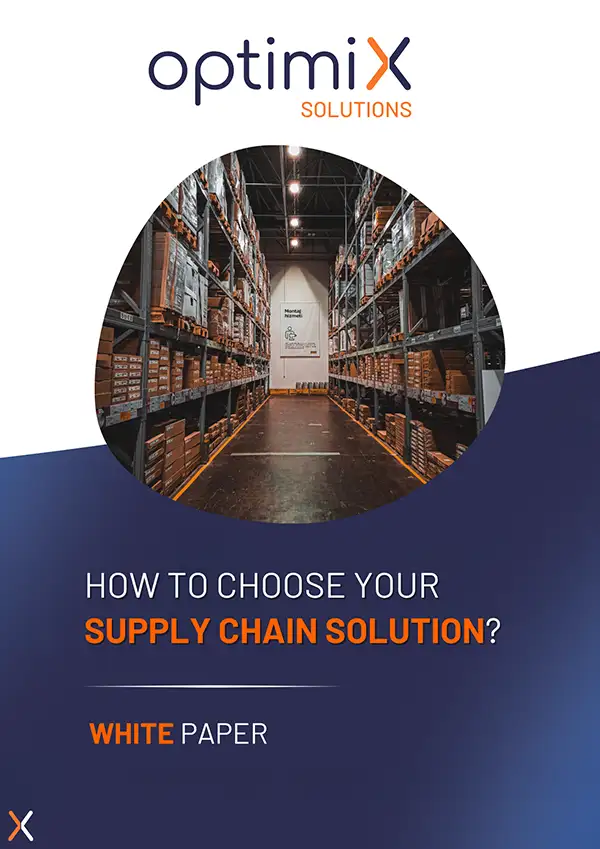The terms ” inventory management ” and ” inventory optimization ” are often used synonymously. However, they refer to two distinct but complementary approaches, the mastery of which can transform a company’s operational and financial performance.
Inventory management focuses on day-to-day management: monitoring incoming and outgoing goods, anticipating stock-outs and guaranteeing product availability.
Inventory optimizationtakes a more strategic view. Its aim is to maximize the value created by each euro immobilized, by striking the right balance between customer service, logistics costs and cash flow.
This article looks at the key differences between these two approaches, their respective objectives and the best practices for moving from an operational management rationale to a sustainable, high-performance optimization approach.
Why is good inventory management a key performance driver?
Inventory is often one of the largest items on a retail or manufacturing company’s balance sheet. For a retailer, it can represent 30 to 50% of total assets, making inventory more than just an operational variable: it’s a major strategic lever for creating or destroying value.
A well-managed and optimized inventory generates multiple benefits. First and foremost, it guarantees product availability, an essential element in customer satisfaction. In an omnichannel context, where consumers expect immediate availability, a stock shortage is often the equivalent of a lost sale. Beyond availability, stock has a direct impact on cash flow and profitability. Excessive stock ties up capital and generates high costs, while insufficient stock leads to out-of-stocks and brand image damage. Retailers therefore need to implement best practices for stock optimization.
Business Impact and Risks of Inadequate Management
Out-of-stocks represent an average 4 to 8% loss of sales in the retail sector. Beyond the immediate sales lost, out-of-stocks degrade the customer experience and erode long-term loyalty. Overstocking also generates considerable hidden costs: the cost of tied-up capital (5 to 15% per year), warehousing, insurance, depreciation and obsolescence. For a short-cycle technological product, the rate of depreciation can reach 2 to 3% per month.
On an organizational level, inefficient management creates tensions between departments: sales wants to maximize availability, finance wants to minimize inventory, supply chain wants to optimize flows. Without a shared vision and common tools, these tensions hamper collective performance.
Definition of Inventory Management
Inventory management covers all operations involved in the day-to-day management of goods: receiving, storage, preparation, dispatch and returns management. It is the operational foundation of any logistics or sales activity.
Its objectives are primarily practical: to guarantee the traceability of flows, maintain inventory reliability, avoid preparation errors and ensure compliance with conservation and safety rules. This approach, which is often reactive, involves taking action when a threshold is crossed or a deviation is detected.
Rigorous flow monitoring is essential to maintain consistency between theoretical and actual stock levels. Annual, rotating or permanent inventories are used to verify this reliability, with a rate of over 98% generally considered satisfactory.
High-performance management relies on digital tools such as WMS, barcodes, RFID and IoT, specialized software that ensures real-time tracking and minimizes errors. These technologies enhance data accuracy and operational productivity, while providing complete visibility of stock movements.
Definition of Inventory Optimization
Inventory optimization takes a strategic approach to determining the optimum stock level, i.e. the one that maximizes value while maintaining a balance between product availability, financial investment, carrying costs, risks of stock-outs and overstocks.
The aim is to find the equilibrium point where the cost of holding an additional unit equals the potential cost of a stock-out. This stock optimization logic enables levels to be adjusted according to the nature of the items: high-margin products require higher safety stocks, while slow-moving references need to be managed more finely to avoid any surplus.
Inventory optimization relies on analytical and predictive models: ABC-XYZ classification to prioritize SKUs according to their value and the stability of demand, safety stock models which take into account the variability of sales and lead times, and the Economic Order Quantity (EOQ) to reduce ordering and holding costs.
Forecasting solutions play a central role: based on statistical analysis, machine learning and predictive AI, they enable us to anticipate demand, prevent shortages, limit overstocking and continuously adjust supply policies.
Main differences between Management and Optimization
Operational Vision vs. Strategic Vision
Management takes an operational view, focusing on day-to-day execution and process compliance. Optimization embraces a strategic vision that looks at the value created and connects inventory to overall business objectives. The indicators monitored differ: operational KPIs (inventory reliability, productivity) for management, strategic indicators (rotation, stock coverage, ROIC) for optimization.
Proactivity, Anticipation and Data-driven Management
Management operates in reactive mode, responding to events. Optimization adopts a proactive stance: it anticipates evolutions via forecasting, adjusts parameters before problems arise, and simulates scenarios. Data-driven management is at the heart of modern optimization: machine learning algorithms analyze millions of pieces of data to detect patterns and seasonality, creating a continuous improvement loop.
Expected results and key indicators
Management is measured in terms of compliance and operational efficiency: reliability rate over 98%, error rate under 0.5%. Optimization targets business results measurable in euros: reduction of average stock by 15 to 30%, increase in rotation, reduction in markdowns, improvement in service rate. Sophisticated indicators are emerging: optimal stock calculated by category, deviation from optimal stock, total cost of ownership.
Turn inventory management into a competitive advantage through optimization
The distinction between stock management and stock optimization reflects two radically different levels of maturity. Inventory management, the essential operational foundation, ensures day-to-day operations. Inventory optimization, on the other hand, raises thinking to a strategic level, to maximize the value created.
With margins under pressure and volatility on the rise, optimization is no longer an option, but a strategic necessity. Companies are seeing tangible benefits: improved profitability, cash release, better quality of service, greater agility. The ROI, generally seen in less than two years, more than justifies the investment in tools, skills and change management.
AI and automation technologies are now making optimization capabilities that were previously reserved for large groups accessible to any organization. This democratization is creating a new performance standard. So the question is no longer whether to optimize inventory, but when and how to initiate this process to derive maximum value.








